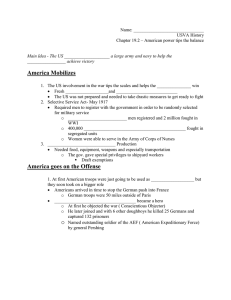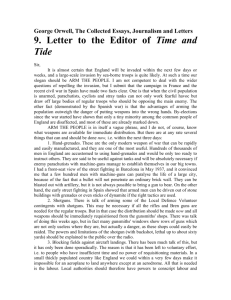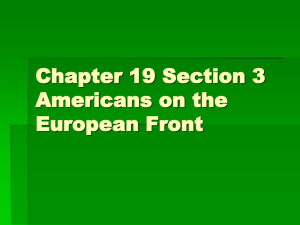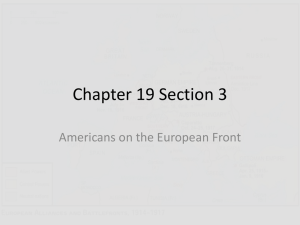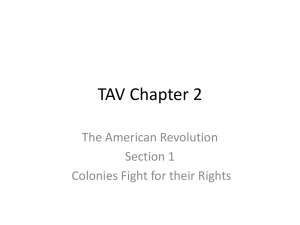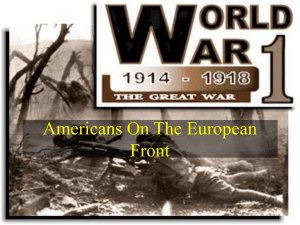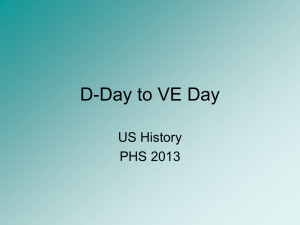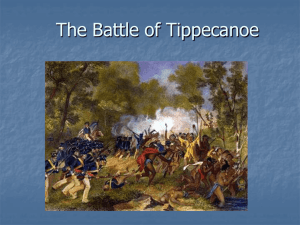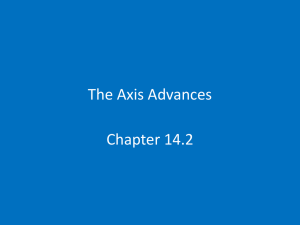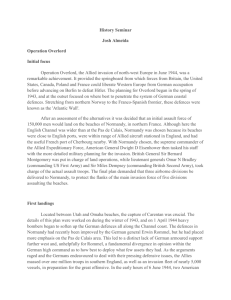Chapter 11 Section 2 American Power Tips the Balance
advertisement
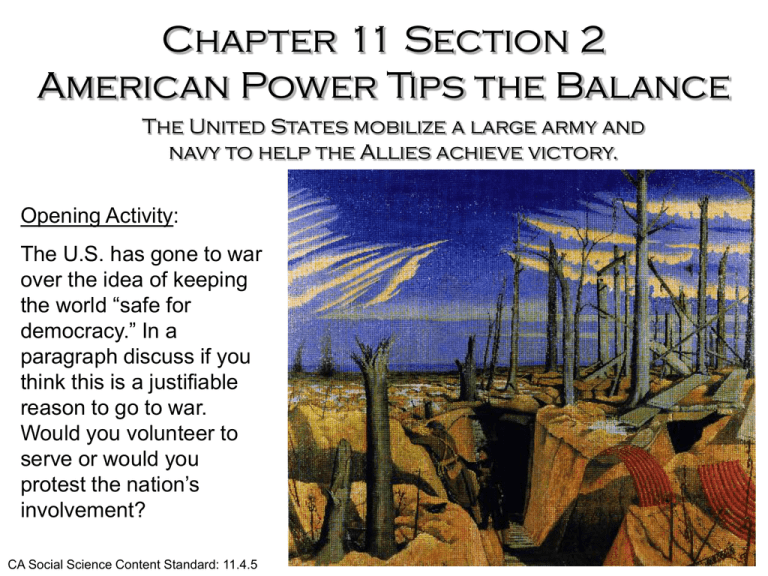
Chapter 11 Section 2 American Power Tips the Balance The United States mobilize a large army and navy to help the Allies achieve victory. Opening Activity: The U.S. has gone to war over the idea of keeping the world “safe for democracy.” In a paragraph discuss if you think this is a justifiable reason to go to war. Would you volunteer to serve or would you protest the nation’s involvement? CA Social Science Content Standard: 11.4.5 Objectives All Students will: 1. Describe how the United States mobilized for war. 2. Summarize U.S. battlefield successes. 3. Identify the new weapons and the medical problems faced in World War I. 4. Describe U.S. offensives and the end of the war. Taking Notes Directions: Fill in the web to show how Americans responded to the war. Define the following terms: American Responses To World War I Selective Service Act convoy system American Expeditionary Force General John J. Pershing Eddie Rickenbacker Alvin York conscientious objector armistice I. America Mobilizes A. Raising an Army -Selective Service Act—men register, randomly chosen for service—forces went from 200,000 to 3,000,000. -African Americans in segregated units, excluded from navy, marines. -Soldiers train for 8 months, often drill with fake weapons. -Women in army, navy, marines as nurses, secretaries, phone operators. B. Mass Production -To expand fleet to transport men, food, equipment, to Europe, United States: *Gives special status to shipyard workers—no draft. *Use prefabrication techniques. *Takes over commercial, private ships. Objective One: America Mobilizes 1. How did the United States raise an army during World War I? The United States raised an army by passing the Selective Service Act which resulted in a randomly selected draft. 2. How did the United States increase ship production? The United States exempted shipyard workers from the draft, public relations campaign, shipyards used prefabrication techniques, and the government took over commercial and private ships and converted them. II. America Turns the Tide A. U.S. Navy Contributions -Convoy System—destroyers escort merchant ships across Atlantic—losses drop dramatically (cut in half). -Navy helps lay mines across North Sea, keep U-boats out of Atlantic. -1918, Germans have difficulty replacing boats, trained submariners. B. Fighting in Europe -After 2 1/2 years of fighting, Allied forces are exhausted, demoralized. -American troops bring numbers, freshness, enthusiasm. Objective Two: America Turns the Tide 1. What was the significance of the convoy system? The convoy system was significant because it cut the losses of ships in half. 2. How did the arrival of new American troops affect the spirit of Allied troops? After 2 ½ years of fighting the Allied forces were exhausted and demoralized…American troops brought freshness and enthusiasm. III. Fighting “Over There” A. Doughboys in Europe -General John J. Pershing leads the American Expeditionary Force (AEF)—soldiers impressed by cities, shocked by battle. B. New Weapons -By 1917, British learn to use tanks to clear path for infantry. -Early planes flimsy, only do scouting; later ones stronger, faster. -American ace Eddie Rickenbacker, other pilots in dogfights. -Observation balloons used extensively, prime target of ace pilots. IV. The War Introduces New Hazards A. New Problems of War -New weapons and tactics lead to horrific injuries, hazards. -Troops amidst filth, pests, polluted water, poison gas, dead bodies. -Constant bombardment, battle fatigue produce “Shell Shock.” -Physical problems include dysentery, trench foot, trench mouth. Objective Three: Fighting “Over There” 1. Who led the American troops in Europe? General John J. Pershing led the American Expeditionary Force “doughboys” in Europe. 2. What new weapons were used during World War I? New weapons used during World War I were the tank and the airplane. 3. How did medical services respond to the physical and emotional wounds suffered by the soldiers? The Red Cross carried the wounded from the battle field to the hospitals…they had to treat “shell shock” and trench foot besides the normal battle wounds. V. American Troops Go on the Offensive A. Allies Stop German Advance -Russia pulls out in 1917; Germans shift armies to western front— come within 50 miles of Paris. -Americans help stop German Advancement, turn tide against Central Powers at Chateau-Thierry and Belleau Wood. B. American War Hero -Conscientious objector—person who opposes war on moral grounds. -Originally a conscientious objector, Alvin York decides WWI is just. -Alone kills 25 Germans; with 6 others captures 132 prisoners. -Promoted to sergeant; becomes U.S. celebrity. C. The Collapse of Germany -November 13, 1918, Austria-Hungary surrenders to Allies. -German sailors, soldiers rebel; socialists establish German Republic—Kaiser gives up throne—signed an armistice (truce) in 1918. D. The Final Toll -WWI bloodiest war in history to date—half of 22 million are civilians—20 million more are wounded. -10 million people become refugees. Objective Four: American troops Go on the Offensive 1. What successes in battles did U.S. troops have? The U.S. was successful in helping stop the German advancement, turn tide against Central Powers. 2. What made Alvin York a hero? Alvin York was a hero by killing 25 Germans and captured 132 prisoners with six other doughboys. 3. What caused the collapse of Germany? 4. Austria-Hungary surrendering to the Allies and German sailors mutinied against government authority…forced the Kaiser to give up his throne cause the collapse of Germany. How many people died during World War I? 22 million people died (half were civilians), 20 million wounded, and 10 million became refugees during World War I. Review Questions 1. The term used to describe a man who refuses to fight in a war because of his religious beliefs is a ____________________. 2. Another word that means the same as being “conscripted” into the Army is _____________. 3. The _____________ system was important for safely getting men and supplies across the Atlantic Ocean. 4. The airplanes and tanks were weapons of ______________ warfare that were introduced in World War I. 5. At the 11th hour of the 11th day of the 11th month of 1918 Germany signed an ______________ after German mutiny spread and the Kaiser gave up the thrown. Words: armistice drafted conscientious objector mechanized convoy

